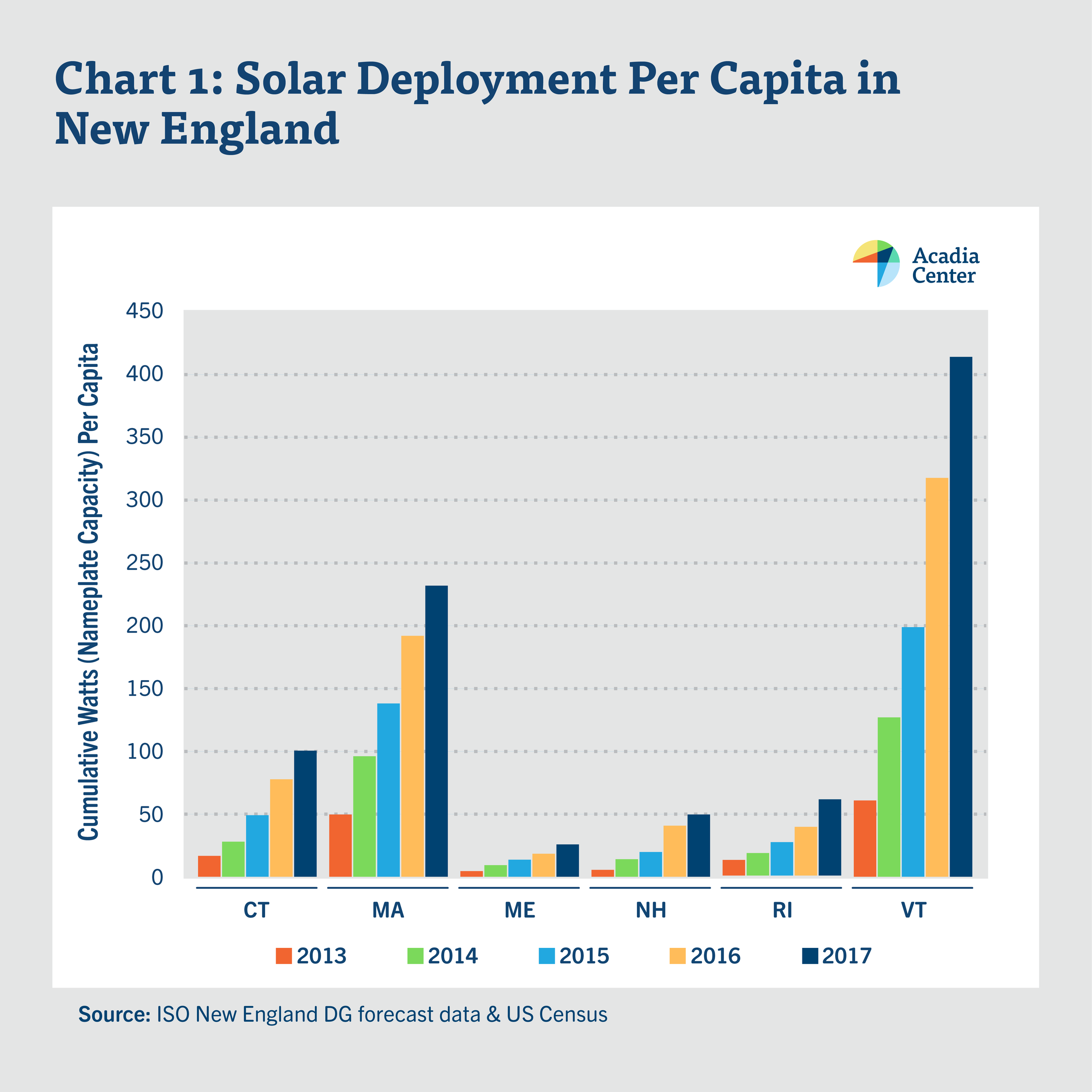One Year In: The Unexpected Gifts of Solar Power
“We are still not doing enough, nor moving fast enough, to prevent irreversible and catastrophic climate disruption.”
By Marina Schauffler
Reports issued in late 2018—including an updated National Climate Assessment and a U.N. Special Report—reinforce the urgency of reducing U.S. carbon emissions, which rose an alarming 3.4 percent in 2018. The pressure is on to address greenhouse gas generation, especially in Maine, which currently lags behind other New England states in solar power generation (see chart on page 24). Massachusetts has nearly six times as much solar installed per person as Maine. According to the nonprofit Acadia Center, Maine must increase its solar installations five-fold to achieve targeted emissions cuts by 2030.
With new leadership in Augusta, Maine may advance the policies and incentives to make that happen — ramping up new installations and relying on solar to charge busses, trucks and cars (as transportation generates 52 percent of Maine’s greenhouse gas emissions). State-level actions will build momentum, but ultimately the choice to generate cleaner, local power falls to individual property owners and those who join community solar projects.
After years of deliberation, during which — happily — solar panel prices dropped markedly, my husband and I installed a 6.4-kilowatt rooftop array late in 2017. That is to say, he did 98% of the work and I helped hoist panels to the roofline (which, in the moment, felt like more than a 2 percent effort!). The research, planning and equipment purchases all went smoothly; the actual installation, not so much. For the record, we do not recommend this DIY approach, regardless of savings.
But now that the panels are up and dutifully generating electricity, we love our array. One year into home power generation, we’re enjoying more benefits than we ever expected.
Having deliberately oversized our system (so we could charge a vehicle in the future), we’ve had an energy surplus every month (even low-light winter ones). We do buy back from the grid at night and on cloudy days, but still have plenty of kilowatt hours to share. Fortunately, Central Maine Power offers a program that allows excess credits to be directed toward the monthly bill of a relative, so we did not lose any credits at the end of the year.
Not all energy systems deliver on their promises, but solar installations come close. The predicted annual yield for our system was 7,705 kWh, and in 2018 it generated 7,250 kWh, a reasonable 6% variance. Another system that went in just before ours, described on the Frugalwoods blog, came even closer to its anticipated yield of 5,667 kWh, with a difference of only 23 kWh.
Generating homegrown power has renewed my motivation to ensure every light bulb is an LED and to cut phantom loads with power strips. Even though we’re not off grid and reliant on batteries, I’ve become more determined to avoid any wasted electricity. It’s akin to saving well water in a drought—not knowing when the rain (or, in this case, sun) will next come.
Monitoring solar generation makes our family more attuned to the weather and shifting seasonal light. Solar panels have gotten better at capturing power even when it’s mildly overcast, or the sun is lower in the sky. We’ve been surprised by how much power we’ve generated in less than optimal conditions. My husband duly tracks these subtle variations, checking the real-time generation online at frequent (some might even say compulsive) intervals.
In the course of installing and using solar power, we’ve worked through a few misconceptions beyond the DIY challenge that should have been obvious. For example, I always envisioned solar as silent (and I’m told that most systems are). But the charge controller fans for our battery back-up do generate a noticeable hum at times. By dumb luck, we placed ours in a remote location. Had we chosen a more central site, the noise would have been annoying.
Yet other concerns we did anticipate — like snow buildup — never materialized. The panels shed snow readily (an upside to the roof pitch that made the installation so challenging!).
There are logistics to consider, but the returns of solar power are significant — and extend beyond just electricity savings. It’s an undeniable thrill to receive a galactic freebie. Like plants relying on photosynthesis, we’re now tapping into a cycle that fuels all life.
By using energy close to the source, we keep that power from traveling along distribution lines — dissipating as heat in a world already grown too warm. Given climate reports, powering our home on sunshine feels like a gift — not just for our household but for our beleaguered planet.
Residential Solar Lessons Learned
Weatherize your home first.
Update roofing, if needed, before panels are installed.
Pay attention to federal and state incentives.
Don’t consider solar a DIY project.
This article first appeared in the Spring/Summer 2019 issue of Green & Healthy Maine HOMES magazine.
Subscribe today!




